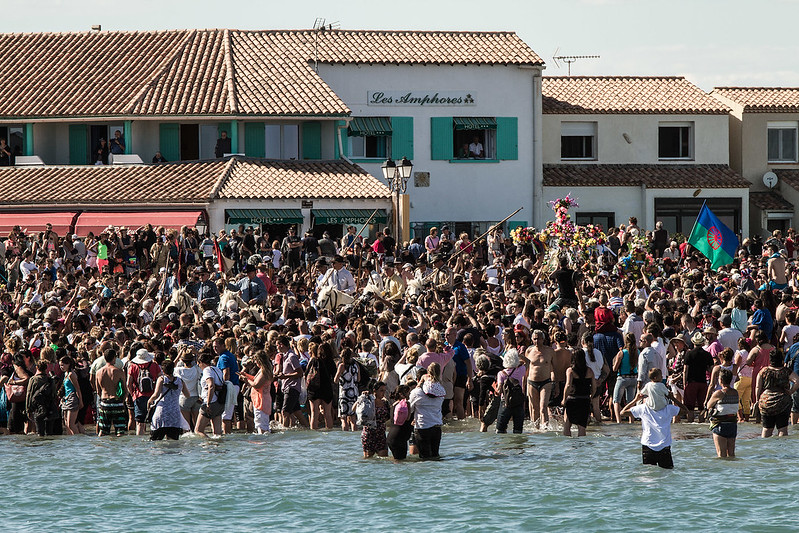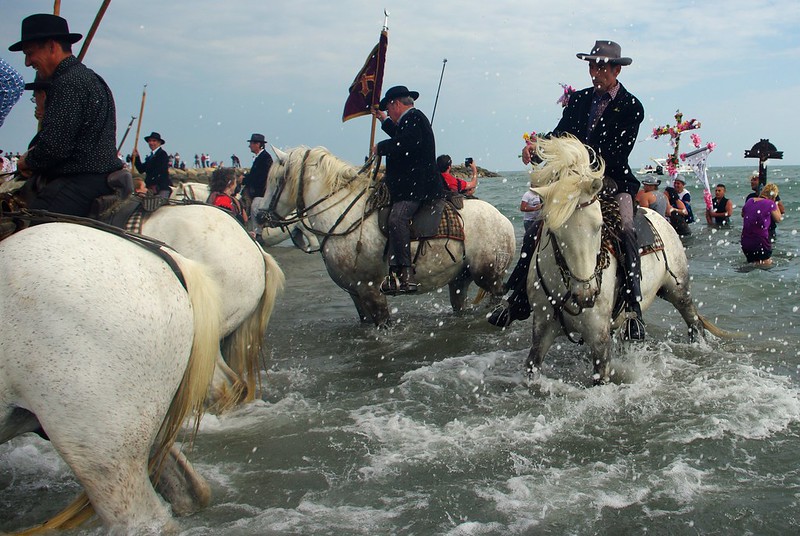Pelerinage des Gitans
A Vivid Fusion of Faith and Roma Culture
2026/05/23 - 2026/05/25
Every May, the small coastal town of Saintes-Maries-de-la-Mer in southern France transforms into a kaleidoscope of color, music, and faith as thousands of Roma people gather for the Pèlerinage des Gitans. Held from May 24th to 26th, this unique pilgrimage celebrates Saint Sarah, the patron saint of the Roma people, combining fervent religious devotion with vibrant cultural celebrations, captivating both participants and spectators for nearly a century.
Main Highlights
Procession of Saint Sarah
The festival's highlight is the procession of Saint Sarah's statue from the church to the sea, held on May 24th. Amid rhythmic chanting of prayers, Roma men dressed in black suits adorned with colorful scarves carry the flower-bedecked statue on their shoulders. The procession winds through narrow streets lined with cheering crowds, and when the statue reaches the Mediterranean, devotees enter the sea, shouting fervent cries of "Vive Sainte Sara!" echoing across the beach.
Descent of the Relics
Inside the fortified church, another scene unfolds as the relics of Saint Mary Jacobe and Saint Mary Salome are slowly lowered from the high chapel in a decorated chest. Traditional Roma songs resonate throughout the church, and the flickering light of hundreds of candles casts dancing shadows on the ancient stone walls. This solemn ceremony, deeply rooted in centuries of tradition, contrasts with the lively festivities outside.
Gypsy Market
The streets of Saintes-Maries-de-la-Mer come alive with a bustling market where Roma artisans showcase their crafts. The clinking of handmade jewelry, the earthy scent of leather goods, and the vibrant swirl of traditional textiles fill the air. Visitors can sample Roma cuisine, such as palacsinta (sweet crepes) and goulash, their rich aromas mingling with the salty sea breeze.
Cultural and Historical Background
The Pèlerinage des Gitans originates from the legend of Saint Sarah, believed by the Roma people to have been the maidservant of the Three Marys who arrived in France to spread Christianity. While the town has long been a Christian pilgrimage site, the specific Roma celebration began in 1935 when Marquis de Baroncelli-Javon proposed including Saint Sarah’s statue in the procession.
This pilgrimage is a significant cultural event for the Roma people, centered around Roma music, primarily featuring the violin and the cimbalom. The cimbalom is a hammered dulcimer, a crucial instrument in Roma bands. During the festival, the Csárdás dance is performed, characterized by its rapid tempo changes, intricate rhythms, and use of the unique Hungarian scale. This music reflects the Roma people's history of developing and integrating their musical traditions with local cultures as they traveled.
The festival also serves as a rare gathering for Roma groups from across Europe, providing an essential platform for showcasing and passing down their arts and traditions to the next generation. Roma music culture has significantly influenced European music history, inspiring numerous classical compositions from the 19th and early 20th centuries.
Participants Voices
I stumbled upon this festival during my trip to France, and it turned out to be one of the most remarkable experiences I've ever had. The procession to the sea was unlike anything I'd ever seen—the devotion, the colors, the music! I was utterly captivated. Watching hundreds of Roma people enter the sea carrying Saint Sarah's statue was breathtaking. I'm neither Roma nor Catholic, but I felt incredibly welcomed. This festival showed me a side of Europe I never knew existed.
Fun Facts
- The statue of Saint Sarah is regularly dressed in colorful outfits, and many believe that touching her garments brings good luck.
- During the festival, the town's population swells from about 2,500 to over 25,000 people.
- Many Roma families use the pilgrimage as an opportunity to baptize their children in the same sea where Saint Sarah is believed to have arrived.
- The region’s native Camargue horses play a significant role in the procession, with local gardians (cowboys) riding them to escort the statue.
- The Church of Saintes-Maries-de-la-Mer, built between the 9th and 12th centuries, also functioned as a fortress to protect against Saracen invasions.
Festival Dates
The Pèlerinage des Gitans takes place annually from May 24th to 26th.
The event schedule is subject to change. Please check the official website for the most up-to-date information.
Information
| Name | Pelerinage des Gitans |
| Country | France |
| Area | Saintes Maries de la Mer |
| Date | 2026/05/23 - 2026/05/25 |
| Link |
Upcoming Festivals
Whirling Dervishes Festival Turkey
A Mesmerizing Dance of Divine Love
2025/12/06Mevlana Celaleddin Rumi Commemoration Ceremony ( Şeb-i Arus ) Turkey
A Whirling Journey to Divine Love
2025/12/10Dia de la Virgen de Guadalupe Mexico
A Festival Weaving Faith, Fervor, and Mexican Identity
2025/12/11L'Escalade Switzerland
Geneva’s Grand Winter Festival of Courage, Chocolate, and Community
2025/12/12Umkhosi Wokweshwama South Africa
The Zulu First Fruits Festival—A Sacred Celebration of Land, Ancestors, and Renewal
2025/12/12Lucia Festival (St. Lucia's Day) Sweden
A Festival of Light Illuminating the Nordic Darkness
2025/12/15Las Posadas Mexico
The Luminous Quest for Sacred Shelter
2025/12/22Noche de Rabanos (Night of the Radishes) Mexico
A celebration blending art, farming heritage, and cultural traditions
2025/12/23Chant of the Sybil on Majorca Spain
A Medieval Prophecy Echoes Through Majorcan Christmas
2025/12/23‘Hatajo de Negritos’ and the ‘Hatajo de Pallitas’ Peru
A Christmas Festival of Rhythm, Faith, and Afro-Andean Heritage in Peru’s Ica Region

